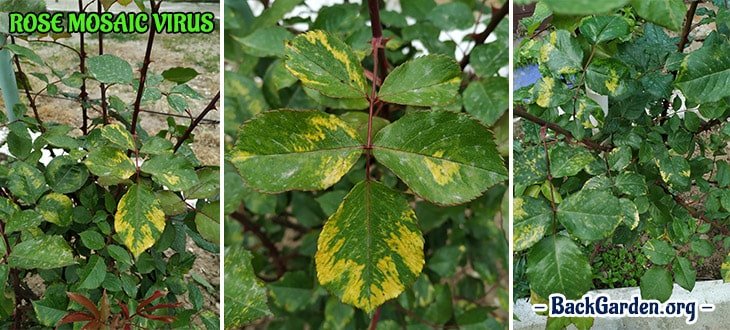The Rose Mosaic Virus – Yellow Pattern On Roses Leaves
I love flowers and I have several rose varieties planted in my garden.
This spring, I noticed that some of the roses had a weird yellow pattern on many of their leaves.
I didn’t know the exact cause of those weird shapes and at first, I thought to be a soil nutrient deficiency.
Eventually, I found out that my roses were sick and infected with a plant virus called the rose mosaic virus (RMV on short).
After a bit of research, I found out some interesting facts about this rose disease and I’m going to share this info in this article.
The following info will teach you how to identify the virus early, how it is spreading, and how to get rid of it and keep your rose garden safe from it as much as possible.
Contents
What is The Rose Mosaic Virus?
The rose mosaic virus is one of the most common viruses that affects roses. It is so prevalent that every year is affecting many people’s roses and degrade the quality of their flower produce significantly.
Causes of the Rose Mosaic Disease
So, what really causes the rose mosaic virus? Is it a special virus that solely attacks rose plants? Or is it many different viruses that attack a wide variety of plants?
The rose mosaic disease is caused by several viruses that are harmful to plants and roses in particular.
Some of these viruses include, but not limited to; apple mosaic virus (ApMV), Arabis mosaic virus (ArMV) and Prunus necrotic ringspot virus(PNRSV). Plus, it goes without saying that these pathogens can attack roses either separately or together in a complex process.
Common Symptoms of The Rose Mosaic Virus
It goes without saying that rose mosaic virus symptoms are highly variable and dependent on three main factors; the variety of the rose plant, virus complex, as well as the environment.
That said, some of the common signs showing that your roses are infected include, but not limited to the following:
- Severe distortion of leaves
- Ring spots on the leaves
- Chlorotic line patterns on the leaves
- Yellow vein banding as well as puckering of the leaves
- Mild mottling of leaves
- Various mottling symptoms
- Intense yellow spot symptom
The leaf blade that is found around the chlorotic area may be distorted or puckered and appear as an oak-leaf pattern. In addition, the chlorotic sections may, once in a while, turn orange or red.
In my case, the most obvious signs of the rose mosaic virus were yellow patterns on the leaves of the roses as you can see in the picture below.

Besides these symptoms, color-breaking of flowers may be witnessed.
The symptoms of the virus usually appear in the spring and remain throughout the growing season.
While affected plants will, in many cases, exhibit the above symptoms, but sometimes they may not display anything regardless of the virus action within them.
It is also worth mentioning that the affected plants tend to be more vulnerable to the damaging effects of the virus during winter. That is the time when they splotch, yellow to the highest degree.
However, in as much as the virus does not kill roses, it does reduce vigor, induce stunted growth and shorten the lifespans of the affected roses. Plus, the plants may become more susceptible to the effects of frost and winter than other healthy roses, in general.
How the Rose Mosaic Virus Spreads
So, how does the rose mosaic virus spread? Does it ambush roses one after the other until it successfully ambushes the entire garden? Or does it spread to other healthy roses through pruning tools that are normally used in the garden as well as insects?
Contrary to what you may think, the rose mosaic virus does not spread through the tools that we use for pruning roses or the insects that feed on the plants.
Instead, the virus infects roses through rooting, grafting or budding cuttings from infected plants.
It is important to note that roses infected during any of the aforementioned garden maintenance activities can show no symptoms until spring when roses bloom.
Prevention of the Disease
Unfortunately, there is no known cure for the rose mosaic virus. As such prevention using basic measures is the key to keeping the disease at bay.
Some of these measures include:
- Get rid of all infected roses immediately. You can look out for the above symptoms to identify infected plants.
- Avoiding working in the garden during damp conditions since the virus can be spread easily when plants are wet.
- Avoiding smoking cigarettes around your roses since tobacco is a well-known carrier of many different plant viruses.
- Get rid of weeds since some types may serve as hosts for the disease.
Final Thoughts
The rose mosaic virus is a notorious plant pathogen that can infect your roses and negatively affect the quality of your flowers.
The worst part is that once it gets inside your plants, it stays there forever as there is no known cure for it.
To avoid this, knowing the symptoms of the virus to look out for and getting rid of the infected plants immediately before your entire garden is infected is critical. So is understanding the other basic measures to prevent the virus and keep it away from your garden.
Sources:
- Rose Mosaic Virus by Natalie P. Goldberg
- Rose Mosaic Disease by Dustin Blakey

